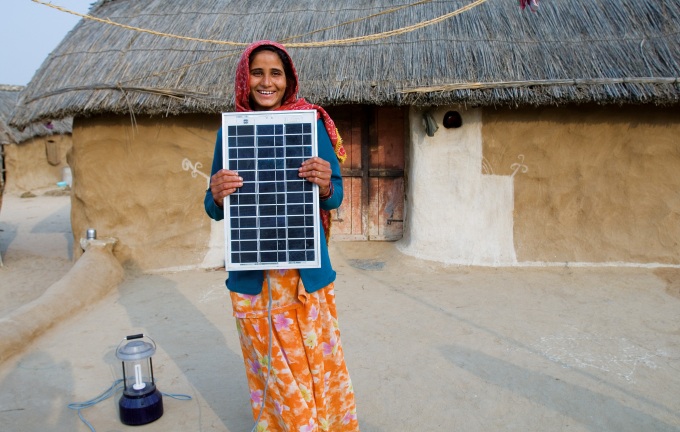A new study reveals that, if successful, India’s wind and solar energy plans can give employment to over a million people

A woman solar engineer who helped electrify Legga village in Rajasthan (Image by Knut-Erik Helle)
If Prime Minister Modi’s vision of 100 gigawatt (GW) solar energy by 2022 comes true, its benefits would stretch beyond energy security and environmental paybacks. According to a new study, it could create a million green jobs in India, where large scale unemployment is one of the top socio-economic issues.
Further, achieving India’s proposed target of 60 GW of wind energy by 2022 could also generate an additional 180,000 jobs.
The number of jobs created in the green energy sector could actually be much higher as the study doesn’t include jobs created in the manufacturing sector.
The study, called Clean Energy Powers Local Job Growth in India, was undertaken by the Natural Resources Defence Council (NRDC) and the Council on Energy, Environment and Water (CEEW). It found that these jobs would come from project planning, construction, installation and operations required to meet the renewable energy targets and could be created in less than a decade.
Government officials find the results encouraging for the renewable energy sector.
“These job projections give us even more drive to make our solar target, the most aggressive one in the world, a reality,” said Tarun Kapoor, Joint Secretary, Ministry of New and Renewable Energy (MNRE). “Now we know what type of skill creation we need to invest in and can take the necessary steps to make that happen.”
A previous study estimated that the Indian solar market has already employed approximately 24,000 workers during the first phase of Solar Mission in 2011-14. According to the government estimates, the wind sector development has produced an additional figure of 45,000 FTE (Full-time equivalent) jobs so far.
“Prime Minister Modi’s clean energy plan creates enormous potential for India’s booming population. It provides job opportunities and access to electricity that will power rapidly growing cities and villages,” said Anjali Jaiswal, Director of NRDC’s India Initiative. “India is aiming to produce more solar energy than any other country in the world, which is an ambitious goal and shows how serious the government is about creating a clean energy economy. Our research has found unequivocally that renewable energy can drive economic development in all corners of the country.”
While under the new government, there is much emphasis on giant projects like solar farms, the analysis showed that they produce the least number of jobs among various types of solar projects. On the other hand, labour-intensive rooftop solar projects produce maximum number of jobs – both short-term and long-term.
The study examined three scenarios and found if the 100GW solar target is achieved through the current mix of project types as proposed by MNRE – 40GW rooftops, 40GW of large-scale projects and 20GW solar parks – it will yield over 1,080,000 FTE. But, if solar rooftop is prioritized in India, then with a mix of 60GW rooftops and 40GW large-scale projects, the country would get the maximum benefit of 1,310,000 jobs. The report clearly recommends that rooftop solar systems be given priority.
As for wind energy, India ranks fifth in the world. This sector can generate 183,500 jobs if 60GW of wind power capacity gets installed by 2022. According to the estimates, 59% of these jobs would be for semi-skilled workers while 21% would require unskilled workers; 81% of these would be one-time jobs such as construction while 19% would be permanent.
Arunabha Ghosh, CEO of CEEW, said, “Clean and renewable energy is going to be a growing share of India’s energy mix in the coming years and decades. In addition to contributing to energy access and mitigating greenhouse gas emissions, there is a clear third benefit: jobs. CEEW and NRDC’s analysis shows that there is huge opportunity to create jobs across the renewable energy value chain. We must collectively work towards realizing this potential.”
The study also documented a growing need for more accurate tracking of job creation data. The analysis showed that because companies in India do not often report the number of jobs created by their projects, scant data exists on the economic impact of clean energy development on employment. According to the analysis, “simple data reporting on the number of jobs created for new solar and wind projects can inform decision-making by policymakers and financiers to choose solar project types with the highest economic opportunity for Indian workers, among other considerations.”
In January, Prime Minister Modi and US President Barack Obama strengthened their clean energy cooperation during the US-India summit, creating joint programmes to scale up renewable energy and create jobs through transnational investment strategies. In December, Modi had raised the solar energy target from 20 GW to 100 GW of grid-connected solar energy by 2022.
India’s solar and wind programmes have already catalysed remarkable growth. The study states that in just four years, India’s solar market has grown more than a hundredfold, exceeding 3GW of installed capacity. With 250GW of total installed energy currently and a need for much more power, scaling up solar and wind energy projects is a win-win strategy. As a result of this, despite limited data, the study estimates that grid-connected solar and wind energy development have created nearly 70,000 full-time jobs in India.
At a time when the price of crude oil has gone down to $50 a barrel – more than half from the peak $107 last June – experts are hoping that the findings of the study will give the renewable sector a much-needed push.

Shows the hope, but economic viability and its cost effectiveness along with desired minimum scale of operation will be worth seeing. However, i wish it opens immense number of jobs. Looking forward to development ahead.